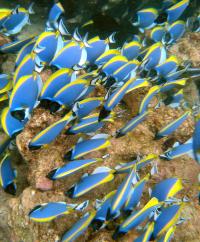
A study on the recovery rates of fishes in exploited reef systems on the coast of Kenya found that some species, such as the powder blue tang, may need decades to recover to pre-fishing levels. Credit: Tim McClanahan/Wildlife Conservation Society In the longest running study on how fish populations in coral reef systems recover from heavy exploitation, researchers from the Wildlife Conservation Society (WCS) and others have found that the fish can recover, but they need lots of time – decades in some cases. The study appears in a recent edition of the journal Ecological Applications.
With nearly continuous data spanning some 37 years from four national marine parks off the coast of Kenya which were closed to fishing at different times, the study found that commercially important species such as parrotfish, wrasses, and surgeonfish can take a quarter of a century to recover fully. More importantly, the ecological equilibrium needed for a healthy reef system, which relies on the interplay of many fish, invertebrate, and plant species, take even longer to achieve, and certainly longer than the length of the study. Most fish recovery studies are conducted with small data sets in short durations of time.
“There’s a pressing need for long-term studies on how fish communities in reef ecosystems rebuild when fishing is banned,” said WCS researcher Dr. Tim McClanahan, the lead author of the study. “This study gives us some important insights in how the different fish species recover and how these communities affect the health of the reef as a whole.”
Specifically, the study examined the recovery rates of eight dominant fish families in Kenya’s marine national parks between 1987 and 2005 using counts that measured fish diversity, size, and density. What the researchers found is that species diversity peaked and stabilized 10 years after a marine park was closed to fishing. The recovery rates of different families and species, however, occurred at different rates, partly as a result of competition for resources among different species. For instance, most parrotfish took some 10-20 years to recover, but then declined, perhaps as a result of competition from a variety of surgeonfish.
A group of fish known as wrasses increased and then peaked in diversity and numbers after 10 years and then their abundance declined, perhaps as a result of competition with triggerfish for the same invertebrate prey. One species of triggerfish—the orange-lined triggerfish—became dominant in the parks with the longest fishing bans, actively excluding other competitors from territories.
Triggerfish are important in another respect; they feed on sea urchins, which in turn feed on the reef-building algae on which the entire reef system depends. When fishing eliminates species that prey on sea urchins, the invertebrates can severely impact the entire system, so keeping sea urchins in check is vital to coral reefs.
Overall, the time frame needed by surgeonfish and tangs, triggerfish, rabbitfish, and the coral-building algae to completely rebuild their populations to pre-fishing levels may exceed the length of the study.
“Decisions made by managers to close areas to fishing in an effort to save fish populations can be unpopular but necessary,” added McClanahan. “What this study has shown us is that many fish populations take long periods of time to recover fully, and that permanent bans on fishing in some parks are necessary if we’re to conserve healthy coral reef systems.” Source : Wildlife Conservation Society
 Print Article
Print Article Mail to a Friend
Mail to a Friend
